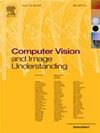基于神经过程的连续条件视频合成
IF 3.5
3区 计算机科学
Q2 COMPUTER SCIENCE, ARTIFICIAL INTELLIGENCE
引用次数: 0
摘要
不同的条件视频合成任务,如帧插值和未来帧预测,通常由特定于任务的模型单独解决,尽管它们具有共同的潜在特征。此外,大多数条件视频合成模型仅限于在特定的整数时间步长生成离散帧。本文提出了一个同时解决这两个挑战的统一模型。我们证明了条件视频合成可以被表述为一个神经过程,其中输入时空坐标通过对上下文时空坐标和像素值的调节被映射到目标像素值。我们的方法利用基于transformer的非自回归条件视频合成模型,该模型将坐标和上下文像素特征的隐式神经表示作为输入。我们的任务特定模型在跨多个数据集的未来帧预测和帧插值方面优于以前的方法。重要的是,我们的模型可以在任意高帧率下实现时间连续视频合成,优于以前的最先进技术。我们的模型的源代码和视频演示可以在https://npvp.github.io上获得。本文章由计算机程序翻译,如有差异,请以英文原文为准。
Continuous conditional video synthesis by neural processes
Different conditional video synthesis tasks, such as frame interpolation and future frame prediction, are typically addressed individually by task-specific models, despite their shared underlying characteristics. Additionally, most conditional video synthesis models are limited to discrete frame generation at specific integer time steps. This paper presents a unified model that tackles both challenges simultaneously. We demonstrate that conditional video synthesis can be formulated as a neural process, where input spatio-temporal coordinates are mapped to target pixel values by conditioning on context spatio-temporal coordinates and pixel values. Our approach leverages a Transformer-based non-autoregressive conditional video synthesis model that takes the implicit neural representation of coordinates and context pixel features as input. Our task-specific models outperform previous methods for future frame prediction and frame interpolation across multiple datasets. Importantly, our model enables temporal continuous video synthesis at arbitrary high frame rates, outperforming the previous state-of-the-art. The source code and video demos for our model are available at https://npvp.github.io.
求助全文
通过发布文献求助,成功后即可免费获取论文全文。
去求助
来源期刊

Computer Vision and Image Understanding
工程技术-工程:电子与电气
CiteScore
7.80
自引率
4.40%
发文量
112
审稿时长
79 days
期刊介绍:
The central focus of this journal is the computer analysis of pictorial information. Computer Vision and Image Understanding publishes papers covering all aspects of image analysis from the low-level, iconic processes of early vision to the high-level, symbolic processes of recognition and interpretation. A wide range of topics in the image understanding area is covered, including papers offering insights that differ from predominant views.
Research Areas Include:
• Theory
• Early vision
• Data structures and representations
• Shape
• Range
• Motion
• Matching and recognition
• Architecture and languages
• Vision systems
 求助内容:
求助内容: 应助结果提醒方式:
应助结果提醒方式:


